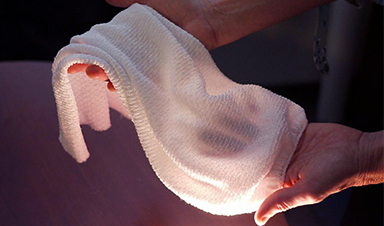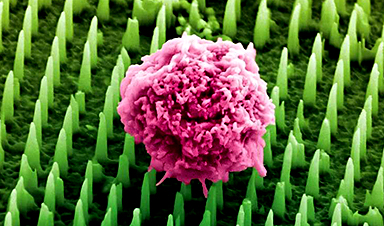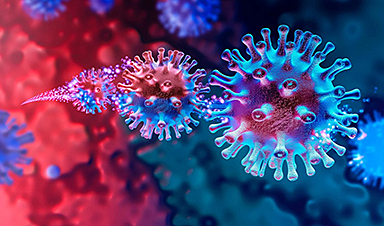Sometimes it is too cold for us and then too warm again – annoying dressing-undressing of sweaters and co. Is therefore required. However, that may change: researchers have developed a sophisticated textile that can independently adapt its thermal properties to how hot, sweaty or cold the wearer is: the innovative fabric warms or cools as needed.
The human organism is like a radiator – we radiate heat. How much infrared radiation we emit into the environment can be regulated by clothing. In this context, material researchers have always developed sophisticated textiles in recent years. However, they can usually only be either or: Some materials insulate extremely well, thereby keeping the body warm. Others, on the other hand, can give off intense heat radiation to cool. A textile that can dynamically move from one function to another has not existed so far, say researchers around Yu Huang Wang of the University of Maryland at College Park. However, this ability should now possess their newly developed material.
Refined fibers with nano-coating
They report that the innovative fabric is made from specially assembled fibers coated with carbon nanotubes. The carrier material is composed of two different polymer materials which react in a contrary manner to moisture and heat with deformation. The dynamic properties of the material are based on this effect, explain the scientists: In moisture or heat, the fibers warp and thus change the structure of the material.
This process opens pores in the fabric that allow heat to escape, the researchers say. But the real highlight is the second effect: The structural change causes an electromagnetic coupling between the carbon nanotubes in the coating. This then leads to increased heat radiation of the material. In sweaty conditions, it thus ensures cooling. On the other hand, if the fabric is cold or dry, the opposite effect occurs: the pores close and the change in the electromagnetic coupling between the carbon nanotubes reduces the heat radiation. This gives the fabric an insulating effect.
“In simple terms, the concept is similar to the effects of radio antennas,” says Wang, “bending two antennas closer together changes their response to electromagnetic waves. The fibers in our material are similar: depending on how close or far they are brought together, their response to infrared radiation changes, “Wang said. At the level of the whole fabric this means that the material can emit more or less heat according to the conditions and thus keep the body warm or cool.
Literally cool clothes in planning
Concretely, the previous test results showed that the infrared-adapive material can change its heat radiation by more than 35 percent. As the researchers report, the fabric also appears to be well suited for use as a textile material with regard to further properties: the basic substances for producing the fibers are readily available and the carbon coating can be applied without problems. In addition, the fabric can be dyed and washed, the developers say.
Nevertheless, the substance has yet to be further optimized and tested until it can be incorporated into products, the scientists emphasize. However, they are confident that some day clothes will be based on their concept: “I find it very exciting to be able to use the material for the development of fabrics that can improve the functionality of garments and other fabrics,” says Co-author Min Ouyang.
Image Credit: Faye Levine, University of Maryland
Thanks to Heinz V. Hoenen. Follow him on twitter: @HeinzVHoenen
News This Week
Johns Hopkins Researchers Uncover a New Way To Kill Cancer Cells
A new study reveals that blocking ribosomal RNA production rewires cancer cell behavior and could help treat genetically unstable tumors. Researchers at the Johns Hopkins Kimmel Cancer Center and the Department of Radiation Oncology and Molecular [...]
AI matches doctors in mapping lung tumors for radiation therapy
In radiation therapy, precision can save lives. Oncologists must carefully map the size and location of a tumor before delivering high-dose radiation to destroy cancer cells while sparing healthy tissue. But this process, called [...]
Scientists Finally “See” Key Protein That Controls Inflammation
Researchers used advanced microscopy to uncover important protein structures. For the first time, two important protein structures in the human body are being visualized, thanks in part to cutting-edge technology at the University of [...]
AI tool detects 9 types of dementia from a single brain scan
Mayo Clinic researchers have developed a new artificial intelligence (AI) tool that helps clinicians identify brain activity patterns linked to nine types of dementia, including Alzheimer's disease, using a single, widely available scan—a transformative [...]
Is plastic packaging putting more than just food on your plate?
New research reveals that common food packaging and utensils can shed microscopic plastics into our food, prompting urgent calls for stricter testing and updated regulations to protect public health. Beyond microplastics: The analysis intentionally [...]
Aging Spreads Through the Bloodstream
Summary: New research reveals that aging isn’t just a local cellular process—it can spread throughout the body via the bloodstream. A redox-sensitive protein called ReHMGB1, secreted by senescent cells, was found to trigger aging features [...]
AI and nanomedicine find rare biomarkers for prostrate cancer and atherosclerosis
Imagine a stadium packed with 75,000 fans, all wearing green and white jerseys—except one person in a solid green shirt. Finding that person would be tough. That's how hard it is for scientists to [...]
Are Pesticides Breeding the Next Pandemic? Experts Warn of Fungal Superbugs
Fungicides used in agriculture have been linked to an increase in resistance to antifungal drugs in both humans and animals. Fungal infections are on the rise, and two UC Davis infectious disease experts, Dr. George Thompson [...]
Scientists Crack the 500-Million-Year-Old Code That Controls Your Immune System
A collaborative team from Penn Medicine and Penn Engineering has uncovered the mathematical principles behind a 500-million-year-old protein network that determines whether foreign materials are recognized as friend or foe. How does your body [...]
Team discovers how tiny parts of cells stay organized, new insights for blocking cancer growth
A team of international researchers led by scientists at City of Hope provides the most thorough account yet of an elusive target for cancer treatment. Published in Science Advances, the study suggests a complex signaling [...]
Nanomaterials in Ophthalmology: A Review
Eye diseases are becoming more common. In 2020, over 250 million people had mild vision problems, and 295 million experienced moderate to severe ocular conditions. In response, researchers are turning to nanotechnology and nanomaterials—tools that are transforming [...]
Natural Plant Extract Removes up to 90% of Microplastics From Water
Researchers found that natural polymers derived from okra and fenugreek are highly effective at removing microplastics from water. The same sticky substances that make okra slimy and give fenugreek its gel-like texture could help [...]
Instant coffee may damage your eyes, genetic study finds
A new genetic study shows that just one extra cup of instant coffee a day could significantly increase your risk of developing dry AMD, shedding fresh light on how our daily beverage choices may [...]
Nanoneedle patch offers painless alternative to traditional cancer biopsies
A patch containing tens of millions of microscopic nanoneedles could soon replace traditional biopsies, scientists have found. The patch offers a painless and less invasive alternative for millions of patients worldwide who undergo biopsies [...]
Small antibodies provide broad protection against SARS coronaviruses
Scientists have discovered a unique class of small antibodies that are strongly protective against a wide range of SARS coronaviruses, including SARS-CoV-1 and numerous early and recent SARS-CoV-2 variants. The unique antibodies target an [...]
Controlling This One Molecule Could Halt Alzheimer’s in Its Tracks
New research identifies the immune molecule STING as a driver of brain damage in Alzheimer’s. A new approach to Alzheimer’s disease has led to an exciting discovery that could help stop the devastating cognitive decline [...]






















Leave A Comment